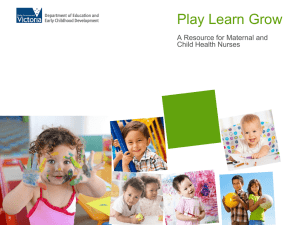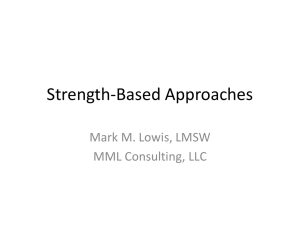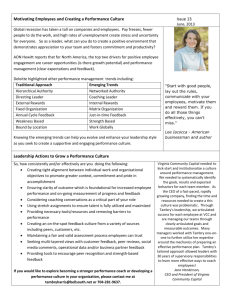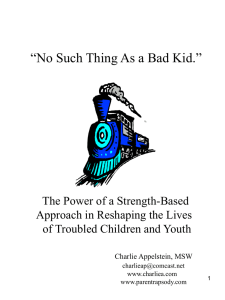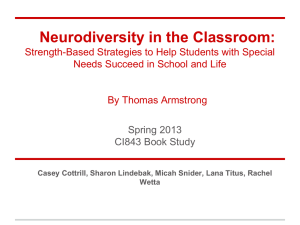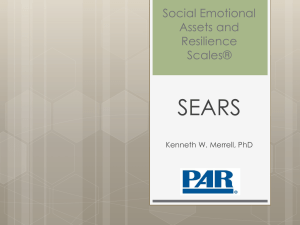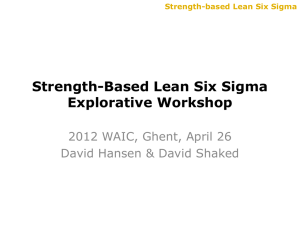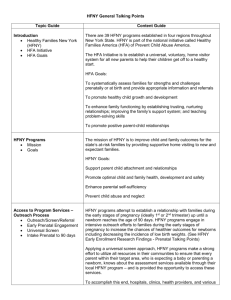Intention and outcome
advertisement
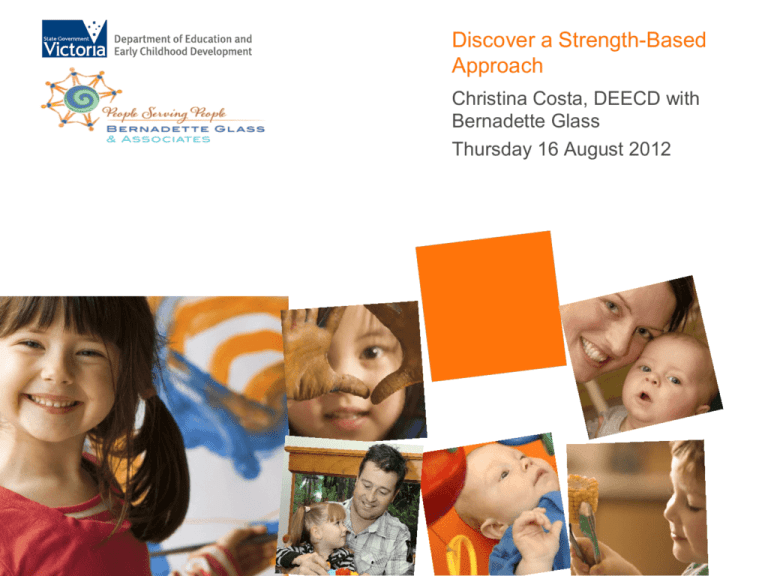
Discover a Strength-Based Approach Christina Costa, DEECD with Bernadette Glass Thursday 16 August 2012 Presentation outline • • • • • • • • Intention and outcome Fundamental What it is and what it isn’t Principles Practice Communication Reflection Key messages Intention and outcome • The intention of the presentation is to… – reflect on your practice and communication from a strength-based perspective – consider the relationship with VEYLDF, assessment and NQF – acknowledge where the strength-based approach already exists and where it could be extended • The outcome of the presentation is that you leave with… – a deeper understanding of the strength-based approach – confidence to apply it to your daily practice, writing Statements and communication Fundamental to implementation • The strength-based approach is fundamental to the effective implementation of: – The approved Learning Frameworks: VEYLDF, EYLF, MTOP – Enactment of Practice Principles leads to supporting children towards developing the five outcomes – Examples of links to Practice Principles e.g. High expectations for every child. – Transition Learning and Development Statements – National Quality Framework – in particular Quality Area 6 • Knowing a child’s strengths • Builds on assessment for learning Holistic view of outcomes From deficit to strength-based Deficit Positive Strength-based Problem/concern One-sided What works Linh can’t tie her own shoe laces Linh is trying to tie her shoe laces With assistance, Linh can tie her shoe laces Oliver doesn’t like to speak Oliver has good non-verbal communication Oliver uses a range of nonverbal cues such as facial expressions and gestures Lucy won’t sit still and listen Lucy likes to be active Lucy is a ‘hands-on’ learner, learning best from tactile and creative experiences George can’t speak English George speaks Greek ??? Negative Incomplete Potential, Strategies What is it? • The strength-based approach IS… – – – – – – A paradigm shift An approach to people Invites connection to the person, first Non-imposing Respectful of where the other ‘is at’ Fostering honesty, transparency, respect and collaboration in all aspects of practice – Focused on what is ‘present’ as a platform for development – Never minimising or dismissive of concerns What it isn’t! • The strength-based approach is NOT… – Soft and avoidant – Only about “positive” things – A way of communicating that covers up or glosses over legitimate concerns – A model to be learnt – Imposing of ideals and beliefs of the practitioner Principles • Underpinning the strength-based approach are the following principles… – – – – – – We are all essentially the same/equal We are already ‘enough’ We all have strengths and capacities People are experts about their own situation The problem and the person are separate A problem focus can blind us from noticing… • what is present • what is working • what is possible in a situation Practice • Individual pedagogical practice – What is yours? – How does it align with the strength-based approach? • How invested are your ideals and beliefs in another’s development? – Do you say or think ‘should’ frequently about yourself or others? – Is your glass half full or half empty? • A focus on what a child can do is paramount as a platform for expanding capabilities – When the focus is on concerns, contraction replaces possibility Communication • Is part of every day practice – Honest, respectful, sensitive – Reflected in how children are encouraged and supported in daily activities – Informs our relationship with families – Reflects the way we relate to colleagues • Is part of the culture of the setting – Kindergarten / Child care / OSHC / School / etc. • Is reflected in supportive structures – – – – Policies / Procedures Meetings Resources / Information / Pamphlets Transition Learning and Development Statements Examples of strength-based communication • Billie’s vocabulary about butterflies is extensive and we have involved her mum and brother in developing the best strategy to encourage her to share with the rest of the group • Mohamed’s excitement is shown in his raised voice and when needed, he will settle quickly when someone moves close and speaks quietly to him Activity • Think of a time when you experienced challenges communicating a message in a strength-based approach. • Perhaps you could summarise the message using a deficit approach. • Discuss this with the person next to you. • Refer to Table 6, page 14 • Consider how you can frame the message using a strength-based approach. Reflection • Reflect on your practice and communication from a strength-based perspective • Acknowledge where the strength-based approach already exists • Where could it be extended? • Are you already using the approach? Key messages • Transition Learning and Development Statement is a tool for sharing information about a child’s early learning journey – it is a summary of that learning journey • Self-reflection allows educators to develop a critical understanding of their own practice and continually develop the necessary skills to achieve the best outcomes for children • Using the strength-based approach in your daily practice and communication contributes to the brevity of writing Statements…because it’s all there! • Using the strength-based approach is central to creating a positive learning culture Tell us… • How can we grow a culture where strength-based approach is a natural way of expression/communication? • How can we streamline the process for writing Transition Learning and Development Statements? • Email your thoughts, feedback, comments to… psts@edumail.vic.gov.au Resource The document is available for download only at… www.education.vic.gov.au/early learning/transitionschool Practice Guides • Eight Practice Guides to the VEYLDF Practice Principles • By Dr Anne Kennedy and Anne Stonehouse AM • fuse.education.vic.gov.au/ pages/View.aspx?pin=GR H4TT THANK YOU….
